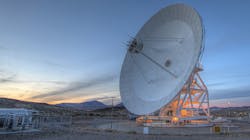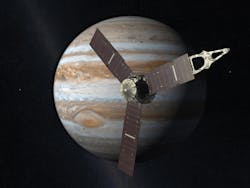Self-regarded sci-fi nerds can thank sci-fact nerds for the beautiful shot of Admiral Kirk’s Starship Enterprise flying past Jupiter in 1979’s "Star Trek: The Motion Picture."
That dead-on portrayal of Jupiter was owed to images of that planet captured by NASA’s Voyager 1 spacecraft, launched in 1977 (and referenced in the movie). Flash forward 42 years and the same kind of antennas built in 1966 to support rock-steady pictures transmitted from NASA’s early spacecraft are being applied today to focus deeper into our universe—with the help of hydraulics.
NASA built its first 70-meter (230-foot) antenna in 1988 to track the Voyager 2 spacecraft as it encountered Neptune and other planets further beyond Earth’s orbit. It needed more powerful communications than those old 60s-era, 64-meter (210-foot) antennas could deliver.
The 70-meter antenna at the Goldstone Deep Space Communications Complex in the Mojave Desert (dubbed the “Mars antenna”) was the first of three giant strategically-sited antennas designed to receive weak signals and transmit very strong ones far out into space. The other two are near Madrid, Spain, and Canberra, Australia.
Although officially dubbed Deep Space Station 14, or DSS 14, the Goldstone antenna picked up the Mars name from its first task: tracking the Mariner 4 spacecraft, which had been lost by smaller antennas after its historic flyby of Mars in 1965.
Acquiring a Target—Using Hydraulics
NASA’s Deep Space Network (DSN) communicates with all spacecraft outside the orbit of Earth’s moon.
Tracking is a heavy job. A 70-meter antenna’s mass (of the azimuth axis) is nearly 2,970 U.S. tons (2.7 million kilograms), and accuracy is more critical than ever for 21st Century NASA missions.
Take the Cassini–Huygens mission to Saturn, for example (Oct. 15, 1997, to Sept. 15, 2017). It presented challenges for the existing 70-meter DSN, requiring vastly improved pointing accuracy to ensure high-data-rate transmissions to and from the Cassini spacecraft at the ringed planet.
Part of that mission’s funding included an upgrade to the control electronics, the hydraulic system, and the replacement of the antenna’s transponders and support systems for the three 70-meter DSN complexes.
Each DSN site’s antenna represents the largest, most-sensitive DSN antenna yet, and is capable of tracking a spacecraft traveling tens of billions of miles from Earth.
The surface of these nearly 3,000-ton, dish-shaped reflectors is maintained to a precision of within a 0.5 inch (1 centimeter) across their entire 41,400 square foot (3,850 square meters) surfaces. This precision is crucial. Even minor deformations would interfere with antenna operations.
A hydrostatic bearing assembly supports each antenna’s tremendous weight on three pads, which glide around a large steel ring on a film of oil the thickness of a sheet of paper. Positioning is—and always has been—accomplished using hydraulics. There’s nothing new about the power and precision of hydraulics in these applications—except to those with just a Trekkie’s understanding of NASA research.
“The antennas have always used hydraulics for drive and control because no other technology can offer the range of speed and positioning precision for such a large moving mass,” explains Gregory Gleason, senior applications engineer‚ Special Technologies, at Bosch Rexroth.
"That was true when it was funded in 1997, and it's still true today. Also, a Rexroth pressure-compensated, variable-displacement pump and closed-loop hydraulic servo valves drive fixed-displacement motors on the elevation and azimuth axes. Smooth break-away motion and rotation under load are critical.”
This is achieved by the low static coefficient of friction from the hydraulics and hydrostatic bearings.
Making Impossible Missions Possible
In many ways, the improved capabilities of these antennas have been crucial to furthering NASA’s ambitious exploration plans for the outer solar system.
Take Jupiter, for example. NASA launched into orbit on its Juno mission on July 4, 2016, after a five-year journey that included an accelerating swing past Jupiter. That swing made the mission’s Juno spacecraft the fastest human-made object ever (165,000 miles per hour).
It passed just 2,800 miles above Jupiter’s cloud tops to begin the first of 37 orbits it will make over the next 20 months while it explores some of Jupiter’s most lingering secrets, including what is at the planet’s core, what drives its extreme magnetic fields, and how this gas giant’s world evolved at the creation of our solar system.
The ground stations of NASA’s DSN will ensure uninterrupted communications with the spacecraft. The three 70-meter parabolic antennas will receive data and images and send control commands to Juno.
The fine positioning of these antennas, made possible by Bosch Rexroth A2FM45 hydraulic motors, will enable the high data transmission rates required to support Juno as it orbits Jupiter more than a billion kilometers (~one light-hour) away.
Deeper Focus on Jupiter’s Moons
Jupiter’s Europa has been a prime target for future exploration since NASA’s Galileo mission (in the late 1990s) found strong evidence for a salty global ocean of liquid water beneath its icy crust. But the revelation that a much smaller moon like Enceladus could also have not only liquid water but chemical energy that could potentially power biology, was a staggering finding for the scientific community.
Many lessons learned during Cassini’s mission are being applied in planning NASA's Europa Clipper mission, planned for launch in the 2020s. Europa Clipper will make dozens of flybys of Jupiter’s ocean moon to investigate its possible habitability, using an orbital tour design derived from the way Cassini explored Saturn.
The mission will orbit the giant planet (Jupiter, in this case) using gravitational assists from large moons to maneuver the spacecraft into repeated close encounters, much as Cassini used the gravity of Titan to continually shape the spacecraft’s course.
NASA’s DSN antennas will prove invaluable for exploring those depths of our universe—and beyond.
Click here for more NASA images from the Juno satellite mission to Jupiter.













